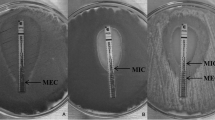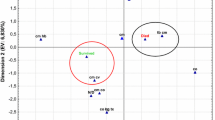Abstract
The aim of the present study was to evaluate the utility of the E test in determining the antifungal susceptibility ofCandida albicans. Reproducibility of the E test was determined for amphotericin B, fluconazole, and itraconazole using three different solid media: RPMI 1640, Casitone, and yeast nitrogen base agar. Minimum inhibitory concentrations (MICs) were comparable (results at ±2 dilutions) in 92% of the tests for amphotericin B and in 100% for fluconazole and itraconazole. Determination of MIC endpoints was easiest on Casitone agar.Candida albicans isolates from 23 patients undergoing fluconazole therapy for oropharyngeal candidiasis were tested for fluconazole susceptibility. Good correlation was obtained between the MICs of fluconazole and clinical outcome. Clinical failure was associated with strains for which MICs were ≥48 Μg/ml. These results suggest that the E test has potential utility for fluconazole susceptibility testing of clinical yeast isolates.
Similar content being viewed by others
References
Espinel-Ingroff A, Pfaller MA: Antifungal agents and susceptibility testing. In: Murray PR, Baron EJ, Pfaller MA, Tenover FC, Yolken RH (ed): Manual of clinical microbiology. American Society for Microbiology, Washington DC, 1995, p. 1405–1414.
National Committee for Clinical Laboratory Standards: Reference method for broth dilution antifungal susceptibility testing of yeasts. Proposed standard M27-P. NCCLS, Villanova, PA, 1992.
Espinel-Ingroff A, Kerkering TM, Goldson PR, Shadomy S: Comparison study of broth macrodilution and microdilution antifungal susceptibility tests. Journal of Clinical Microbiology 1991, 29: 1089–1094.
Sanchez ML, Jones RN: E test, an antimicrobial susceptibility testing method with broad clinical and epidemiologic application. Antimicrobic Newsletter 1992, 8: 1–8.
Espinel-Ingroff A: E test for antifungal susceptibility testing of yeasts. Diagnostic Microbiology and Infectious Disease 1994, 19: 217–220.
Sewell DL, Pfaller MA, Barry AL: Comparison of broth macrodilution, broth microdilution, and E test antifungal susceptibility tests for fluconazole. Journal of Clinical Microbiology 1994, 32: 2099–2102.
Colombo AL, Barchiesi F, McGough DA, Rinaldi MG: Comparison of E test and National Committee for Clinical Laboratory Standards broth macrodilution method for azole antifungal susceptibility testing. Journal of Clinical Microbiology 1995, 33: 535–540.
Wanger A, Mills K, Nelson PW, Rex JH: Comparison of E test and National Committee for Clinical Laboratory Standards broth macrodilution method for antifungal susceptibility testing: enhanced ability to detect amphotericin B-resistantCandida isolates. Antimicrobial Agents and Chemotherapy 1995, 39: 2520–2522.
Espinel-Ingroff A, Pfaller MA, Erwin ME, Jones RN: Interlaboratory evaluation of E test method for testing antifungal susceptibilities of pathogenic yeasts to five antifungal agents by using Casitone agar and solidified RPMI 1640 medium with 2% glucose. Journal of Clinical Microbiology 1996, 34: 848–852.
Pfaller MA, Messer SA, Bolmström A, Odds FC, Rex JH: Multisite reproducibility of the E test MIC method for antifungal susceptibility testing of yeast isolates. Journal of Clinical Microbiology 1996, 34: 1691–1693.
Van Eldere J, Joosten L, Verhaeghe A, Surmont I: Fluconazole and amphotericin B antifungal susceptibility testing by National Committee for Clinical Laboratory Standards broth macrodilution method compared with E test and semiautomated broth microdilution test. Journal of Clinical Microbiology 1996, 34: 842–847.
Rex JH, Rinaldi MG, Pfaller MA: Resistance ofCandida species to fluconazole. Antimicrobial Agents and Chemotherapy 1995, 39: 1–8.
Pfaller MA, Bale M, Buschelman B, Lancaster M, Espinel-Ingroff A, Rex JH, Rinaldi MG, Cooper CR, McGinnis MR: Quality control guidelines for National Committee for Clinical Laboratory Standards recommended broth macrodilution testing of amphotericin B, fluconazole, and flucytosine. Journal of Clinical Microbiology 1995, 33: 1104–1107.
Ghannoum MA, Rex JH, Galgiani JN: Susceptibility testing of fungi: current status of correlation of in vitro data with clinical outcome. Journal of Clinical Microbiology 1996, 34: 489–495.
Hitchcock CA: Resistance ofCandida albicans to azole antifungal agents. Biochemical Society Transactions 1993, 21: 1039–1047.
Goa KL, Barradell LB: Fluconazole. An update of its pharmacodynamic and pharmacokinetic properties and therapeutic use in major superficial and systemic mycoses in immunocompromised patients. Drugs 1995, 50: 658–690.
Author information
Authors and Affiliations
Rights and permissions
About this article
Cite this article
Dannaoui, E., Colin, S., Pichot, J. et al. Evaluation of the E test for fluconazole susceptibility testing ofCandida albicans isolates from oropharyngeal candidiasis. Eur. J. Clin. Microbiol. Infect. Dis. 16, 228–232 (1997). https://doi.org/10.1007/BF01709586
Issue Date:
DOI: https://doi.org/10.1007/BF01709586




